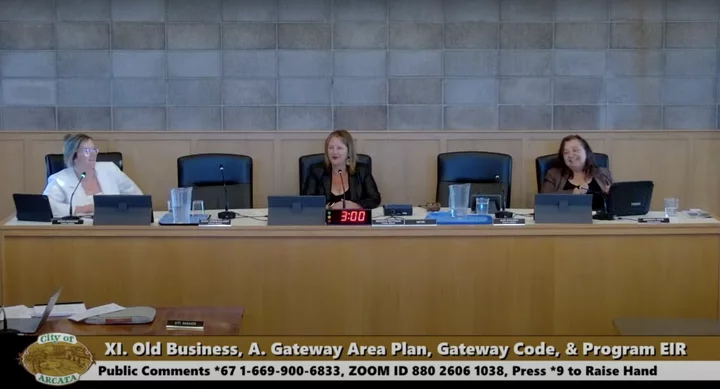Arcata City Council Member Sarah Schaefer, Mayor Mayor Meredith Matthews and Councilmember Kimberley White discuss approving the Gateway Area Plan. Screenshot.
The Arcata City Council approved a final draft of the Gateway Area Plan last night, nearly four two and a half years after the City published a first draft of the blueprint to infill 139 acres of southwest Arcata with high-density housing.
The Council tied up loose ends related to the linear park along L Street and discussed how recent alarm over fire safety in the high-density neighborhood can and will be addressed post-plan approval. (Vice Mayor Alex Stillman and Councilmember Stacy Atkins-Salazar recused themselves from the Gateway Area-related discussion due to conflicts of interest.)
What will happen to L Street has been one of the plan’s hotter topics throughout its development. The street was once slated to become a one-way (in addition to K Street) but the City Council ditched that idea after it stirred opposition in the community.
In its final draft, the plan directs the City to get started on a linear park and a woonerf along L Street – stretching from Samoa Blvd. to 11th Street – within two years.
The plan defines a woonerf as “low-flow, slow-speed, local traffic only street that is designed to safely accommodate bikes, pedestrians, and play, as well as limited use for vehicles,” while a linear park is vehicle-free. Councilmember Sarah Schaefer said it’s likely the woonerf will run from 7th Street to 11th Street (where there is already an existing road), and the linear park will go from 7th Street to Samoa Blvd. Though some commenters asked for specific wording in the plan to guarantee restrictions for the woonerf and linear park, the Council opted to keep the language more open-ended.
Fears over fire safety in the to-be-densified neighborhood have become the other sticking point for some Arcatans. Arcata Fire District Board President Eric Loudenslager and Fire Chief Chris Emmons have said that the fire department currently lacks the staff and resources to address emergencies in tall buildings. An investigation released last month by the Humboldt County Civil Grand Jury found that the department is indeed financially strained.
However, a standards of coverage analysis co-funded by the City of Arcata, the Arcata Fire District and Cal Poly Humboldt will assess future needs of the department, and may identify potential funding sources. That’s expected to wrap up in October.
Public commenters appeared to again call out potential fire risks. Their concern is this: the plan will be passed, buildings will be built, people will move in, and the fire district will fall short in an emergency.
But that series of events excludes some processes and doesn’t reflect how long each of those steps will take, Arcata city staff and council members pointed out. For instance, the standards of coverage analysis will be far past complete by the time builders break ground, and avenues to funding and resources may be well on their way.
When the standards of coverage analysis is done, the Council may amend the plan or code as needed, City Manager Karen Diemer said; it’s a living document.
Meanwhile, the City is actually waiting on the Arcata Fire District board to develop language for fire code. Although there is, technically, fire code currently included in the Gateway Code, “it cannot be effective until the fire department takes action, sends that ordinance to us, asks us to adopt it, [and then] we can either adopt it as is, or amend it,” Community Development Director David Loya said. “Then it will be effective in our code.”
“I know this is an issue that has captured our imaginations,” Loya said. “The reality is that modern building code builds buildings that really don’t catch on fire like that. They’re sprinklered, you’re not going to have a Chicago-style blaze where these buildings are burning down.”
Mayor Meredith Matthews pointed out that local fire departments provide mutual aid, and that seven story buildings are already underway within city limits.
“I think that this fear that: ‘oh my god, it’s gonna happen, and people are gonna be unsafe, and they’re gonna die in a multistory building fire’ is really really outlandish and unrealistic and probably not going to happen,” Councilmember Schaefer said.
“The fire marshall signs off occupancy of buildings, and if we were really in a dire situation where the fire department said: ‘there is no way we can help defend this building,’ then they’re not gonna certify its occupancy and let people live in it.”
Although Councilmember Kimberley White was more concerned than her peers about the fire issue, the three ultimately passed a motion to approve the Gateway Area Plan and Environmental Impact Report, and to introduce an ordinance to adopt the Gateway Code (which will likely be approved at their Aug. 7 meeting).
After Vice Mayor Stillman and Councilmember Atkins-Salazar rejoined the group, the Council quickly and unanimously passed the General Plan 2045. The meeting ended with the Council’s approval to hire Merritt Perry as Arcata’s new city manager. He will replace Diemer next month.
Perry told the Council that he’s always loved opportunities to work in Arcata, from his years as an environmental resources engineering student at Humboldt State University to his time as a consultant in the civil engineering field.
“It was something that always really excited me, to be able to work where I went to school, and I received my education, where I raised my kids,” Perry said. “So I’m really excited at the opportunity to get to know the Council better and to hear the Council’s ideas, and to get to know the community.”

CLICK TO MANAGE